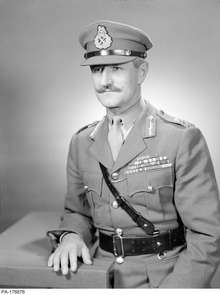George Kitching
Major-General George Kitching (1910–1999) CBE, DSO, CD was a senior Canadian Army officer who saw active service in World War II.

George Kitching was born on 9 September 1910 in Guangzhou (Canton), China.[1] He died on 15 June 1999 in Victoria, British Columbia, Canada.[2] He was the guest of Prince Bernhard of Lippe-Biesterfeld a couple of days before when he fell ill. He never recovered.[3]
Kitching got his military training at the Royal Military College, Sandhurst in the United Kingdom. The British Army gave him several postings in Asia, including Singapore. In 1938 he resigned.
In 1939 he joined the Canadian Army. He was appointed to several position before attending Staff College, Camberley to become a senior officer. Again he held several positions, mainly at the staff of Headquarters 1st Canadian Division and Headquarters I Canadian Corps, before he got his first command in August 1942. Within a few months he was back at the Headquarters of the 1st Canadian Division for the preparations of the invasions of Sicily and Italy. In November 1943 he was promoted to brigadier to command the 11th Canadian Infantry Brigade, followed by the 4th Canadian Armoured Division.
Sacking
Kitching brought the division to Normandy where they were involved in the battle around the Falaise Pocket, in the final stages of the Battle of Normandy. According to the historian Angelo Caravaggio, Kitching was then victimized for the poor performance of the division in Normandy. Caravaggio claims that essential contemporary sources were altered after the sacking of Kitching and are therefore unreliable.[4] To him it seemed that Lieutenant-General Guy Simonds, commanding II Canadian Corps, stripped his subcommanders from authority,[5] did not take the lack of experience in account and expected unrealistic results.[6] Kitching could hardly command his own division due to the constant interference from Simonds.[7][8] Caravaggio comes to the conclusion that Kitching and his inexperienced division performed very well under the difficult circumstances and confusing orders they had to work in. He claims that Simonds is the only one to blame for the late closure of the Falaise Pocket.[9]
The end result of the battle was that Kitching was demoted to brigadier and sent off to command a training unit. Charles Foulkes, commander of I Canadian Corps, had more confidence in his abilities and brought him in as Brigadier, General Staff. He was involved in all operations of the I Canadian Corps until the surrender of the German Forces in the Netherlands.[10]
After the war he stayed in the military until 1965. He held in that time positions like Quartermaster General and Director General of Army Personnel. In 1956 he was promoted to major-general for the second time in his career.
Military senior officer positions held
| From | To | Unit | Role | Rank |
|---|---|---|---|---|
| 01-08-1942 | 13-12-1942 | The Edmonton Regiment (1 Canadian Infantry Division) | Officer Commanding | Lieutenant-Colonel |
| 14-12-1942 | 30-10-1943 | 1 Canadian Infantry Division HQ | General Staff Officer 1 | Lieutenant-Colonel |
| 01-11-1943 | 13-02-1944 | 11 Canadian Infantry Brigade | Officer Commanding | Brigadier |
| 01-03-1944 | 21-08-1944 | 4 Canadian Armoured Division | General Officer Commanding | Major-General |
| 29-08-1944 | 23-10-1944 | 13 Canadian Infantry Brigade | Officer Commanding | Brigadier |
| 12-11-1944 | 01-07-1945 | I Canadian Corps | Brigadier General Staff | Brigadier |
Trivia
- Kitching is a former patron and member of the Board of Trustees of Lester B. Pearson College in Victoria.[11]
Books
- Mud and Green Fields: The Memoirs of Major-General George Kitching (1986)
Notes
- Encyclopædia Britannica
- Encyclopædia Britannica
- "Major-general George Kitching, CBE, DSO, CD" (PDF). Archived from the original (PDF) on 2012-09-05. Retrieved 2011-05-31.
- A Re-evaluation of Generalship Archived 2012-10-04 at the Wayback Machine, p. 2
- A Re-evaluation of Generalship Archived 2012-10-04 at the Wayback Machine, p. 5, 6
- A Re-evaluation of Generalship Archived 2012-10-04 at the Wayback Machine, p. 4
- A Re-evaluation of Generalship Archived 2012-10-04 at the Wayback Machine, p. 3
- A Re-evaluation of Generalship Archived 2012-10-04 at the Wayback Machine, p. 4/5
- A Re-evaluation of Generalship Archived 2012-10-04 at the Wayback Machine, p. 14
- See the video.
- History of the Board